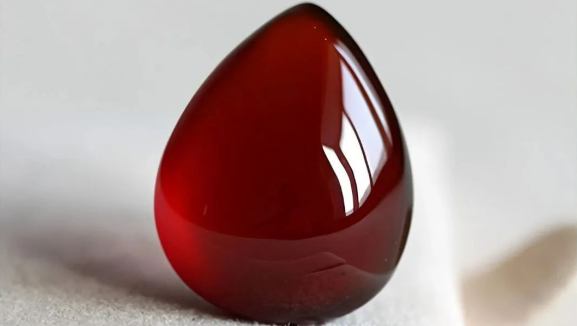What is "garnet"
Garnet, a geological term, is one of the main rock forming minerals in the upper mantle. The shape and color of garnet crystals are very similar to pomegranate seeds, hence the name "garnet". Pomegranate stones with good color and high clarity can become gemstones. The English name for garnet is Garnet, which evolved from the Latin word "Granatum" and means "like a seed". The common garnet is red, but its color range is very broad, covering almost the entire spectrum of colors.
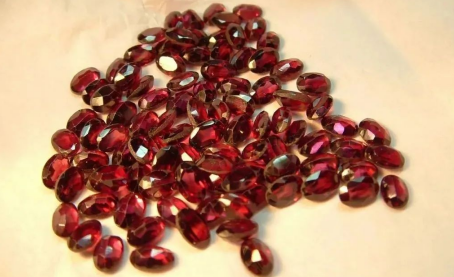
一
Introduction to Garnet
Garnet, formerly known as Ziyawu or Ziyawu in ancient China, is a group of minerals that were already used as gemstones and abrasives during the Bronze Age. The common garnet is red, and the English word for garnet comes from the Latin word "granatus" ("grain"), possibly derived from "Punica granatum" ("pomegranate"). It is a plant with red seeds, and its shape, size, and color are similar to some garnet crystals.
The common types of garnet are confirmed to be six based on their chemical composition, namely Pyrope, Almandine, Spessarite, Andradite, Grossurar (with variations including tsavorite and hessonite), and Uvarovite. Garnet forms two solid solution series: (1) red garnet iron aluminum garnet manganese aluminum garnet and; (2) Calcium chromium garnet calcium aluminum garnet calcium iron garnet. Garnet has no classification internationally. The so-called A's are differentiated based on personal opinions. The same garnet can have different A numbers in the hands of different people.
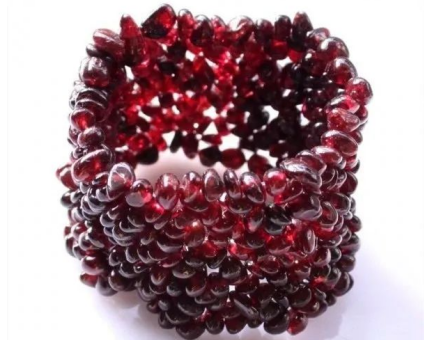
Main components
The chemical composition of garnet is relatively complex, with different elements forming different combinations, thus forming a series of garnet families with similar qualities. Its general formula is A3B2 (SiO4) 3, where A represents a divalent element (calcium, magnesium, iron, manganese, etc.), and B is a trivalent element (aluminum, iron, chromium, as well as titanium, vanadium, zirconium, etc.). Common ones include magnesium aluminum garnet, which contains chromium and iron elements and appears as blood red, purple red, and brownish red; Next is iron aluminum garnet, which is purple red in color and has crystals with developed inclusions, which can be used to create dazzling starlight; Magnesium iron garnet has a light rose purple red color and is one of the important varieties of garnet gemstones; Calcium aluminum garnet contains trace amounts of vanadium and chromium ions, hence it is known as a premium green variety.
Due to the similar radii of trivalent cations, they are prone to homomorphic substitution. Divalent cations are different, as Ca has a larger radius than Mg, Fe, and Mn ions, making it difficult to undergo homomorphic substitution with them. Therefore, garnet is usually divided into two series:
(1)Aluminum series: Mg3Al2(SiO4)3-Fe3Al2(SiO4)3-Mn3Al2(SiO4)3
It is a isomorphic series composed of divalent cations such as Mg, Fe, Mn with smaller radii and trivalent cations mainly composed of Al. Common varieties include magnesium aluminum garnet, iron aluminum garnet, and manganese aluminum garnet.
(2)Calcium series:Ca3Al2(SiO4)3-Ca3Fe2(SiO4)3-Ca3Cr2(SiO4)3
It is a homomorphic series mainly composed of divalent cations Ca with large radii, commonly including calcium aluminum garnet, calcium iron garnet, and calcium chromium garnet. In addition, some garnets also have OH ions attached to their crystal lattice, forming water containing subspecies such as calcium aluminum garnet. Due to extensive isomorphic substitution, the chemical composition of garnet is usually complex. In nature, the composition of garnet is usually a transitional state of isomorphic substitution, with few end member components present.
二
Geological conditions
origin
Magnesium aluminum garnet is mainly produced in ultrabasic rocks and residual slope sand deposits, and large gem grade magnesium aluminum garnet is rare. The former Soviet Union, Norway, Czech Republic, and Jiangsu, China all produced; Magnesium iron garnet is mainly produced in countries such as the United States and Tanzania; Iron aluminum garnet is generated in metamorphic rocks and sand deposits such as mica schist and amphibolite gneiss, and is produced in countries such as Sri Lanka, Brazil, Madagascar, and India; Calcium aluminum garnet is a product of siliceous rocks, but it has also been found in alteration zones of serpentinite and gabbro, such as in Kenya, Pakistan, the former Soviet Union, and China, where green calcium aluminum garnet is produced. Pomegranate is produced in Sri Lanka; Manganese aluminum garnet is found in pegmatite and some metamorphic rocks. Gem grade manganese aluminum garnet is produced in countries such as Myanmar, Sri Lanka, and Brazil; Calcium iron garnet is a product of schist and metamorphic limestone belts, appearing brown and green. Turquoise and eclogite are produced in serpentinite, while black garnet is produced in alkaline rich igneous rocks. It was found in both the former Soviet Union and Congo; Calcium chromium garnet is a product of the interaction between gas formed hydrothermal solutions and calcium containing ultrabasic rocks, which has been discovered in both the former Soviet Union and the United States. Most gem grade garnets are found in alluvial sand deposits.
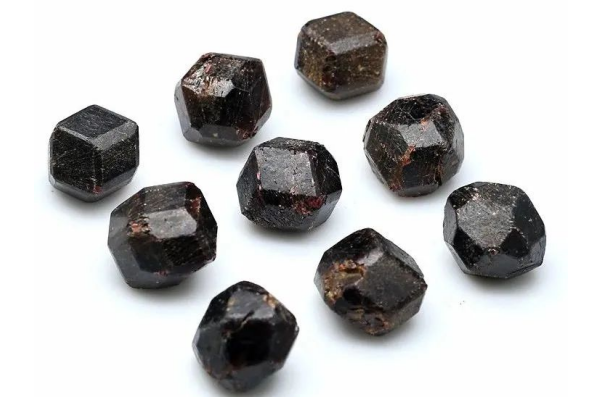
Geological significance
Rock temperature history record
The garnet group is a key mineral for understanding the origin of many igneous and metamorphic rocks using lithospheric thermodynamics. The diffusion rate of elements in garnet is relatively slow compared to other minerals, and garnet is also relatively resistant to metasomatism. So individual garnets that can preserve their internal composite bands will be used to understand the temperature history of the rocks they are in. And some garnets without composite bands are understood to be homogenized due to diffusion, and the singularity caused by the above effects can also be used to infer the history of changes in rock temperature.
Formation conditions
Garnet also plays a role in analyzing the metamorphic conditions of rocks. For example, eclogite can be defined as a rock with basaltic components, but mainly composed of garnet and omphacite. Garnets with a high content of garnet can only be produced in metamorphic rocks under relatively high pressure, such as rocks in the lower crust and mantle. Olivine rocks may contain plagioclase, spinel rich in aluminum, or garnet rich in garnet. If all three minerals coexist, it confirms a pressure temperature zone that balances peridot and pyroxene minerals. The above three minerals are arranged based on their stability in the olivine mineral aggregate under increased pressure. So pomegranate peridotite can only be produced deep in the earth's crust. Xenoliths of garnet peridotite are brought up from depths of 100km or more by kimberlite, and garnets contained in fragments of xenoliths are used as indicator minerals for gold peridotite in diamond exploration. At depths of 300 to 400 km and beyond, the pyroxene components dissolve into the garnet due to the substitution of (Mg, Fe) and Si for 2Al at the octahedral (Y) position, producing an unusually high silicon content garnet with solid solution properties as magnesium iron garnet. This garnet with high silicon content has been confirmed to be included in diamonds.
三
Classification
The color of garnet is influenced by its composition and presents multiple colors, among which the red series includes red, pink, magenta, and orange red; The yellow series includes yellow, orange, dark yellow, and brown yellow; The green series includes emerald green, olive green, and yellow green. The crystal surface has a glassy luster and sub diamond luster, and the fracture surface shows a greasy luster. Transparent to semi transparent. Homogeneous body, without multi-color and birefringence phenomenon. Garnet can be divided into two series and six main varieties: the iron aluminum garnet series (magnesium aluminum garnet, iron aluminum garnet, manganese aluminum garnet) and the calcium iron garnet series (calcium chromium garnet, calcium aluminum garnet, calcium iron garnet).
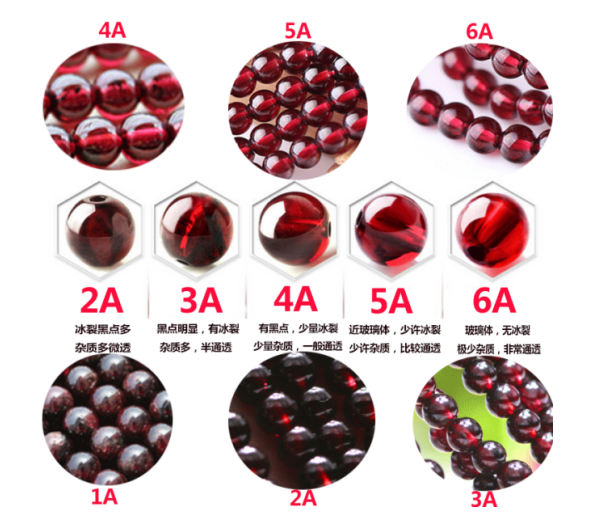
四
Application
Garnet sand is a good abrasive and a commonly used substitute for silica sand in sandblasting. After mixing with high-pressure water, garnet is used for cutting steel and other materials in water jet cutters. Garnet sand is also used as a medium for water purification. Garnet filter material, also known as "jade sand" or "natural diamond sand", has strong hardness and good acid and alkali resistance. It is an island shaped aluminum (calcium) silicate with a variety of beautiful colors, including gray, red, green, white and other chromosomes selected by high-purity magnetic selection. It is a newly developed three-dimensional spray wall coating abroad and the only one that can be used as a color shell sandblasting wear-resistant material in glass shell factories. Due to its high internal chemical molecules and good chemical stability, it has many advantages. It is made by high-temperature smelting of quartz sand, petroleum coke (or coal coke), and sawdust through a resistance furnace.
